Griffon Bruxellois
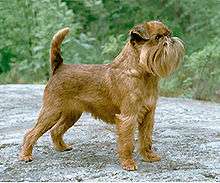 A Griffon Bruxellois | ||||||||||||||||||||||||||
| Other names |
Brussels Griffon Belgium Griffon Petit Brabançon Griffon Belge Brabançon Griffon | |||||||||||||||||||||||||
|---|---|---|---|---|---|---|---|---|---|---|---|---|---|---|---|---|---|---|---|---|---|---|---|---|---|---|
| Common nicknames |
Griffon Griff Bruss | |||||||||||||||||||||||||
| Origin | Belgium | |||||||||||||||||||||||||
| ||||||||||||||||||||||||||
| Notes | Member clubs of the Fédération Cynologique Internationale recognise three separate breeds with similar standards. Other kennel clubs register it as one breed with three variations. | |||||||||||||||||||||||||
| Domestic dog (Canis lupus familiaris) | ||||||||||||||||||||||||||
The Griffon Bruxellois or Brussels Griffon is a breed of toy dog, named for their city of origin: Brussels, Belgium. The Griffon Bruxellois may refer to three different breeds, the Griffon Bruxellois, the Griffon Belge and the Petit Brabançon.[1] Identical in standard except for coat and colour differences, in some standards they are considered varieties of the same breed, much like Belgian Sheepdogs.
History
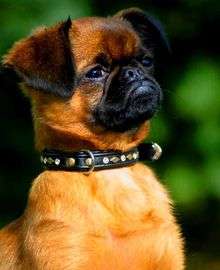
The three variations of this dog, the Brussels Griffon (Griffon Bruxellois), the Belgian Griffon (Griffon Belge), and the Petit Brabançon, all descend from an old type of dog called a Smousje, a rough coated, small terrier-like dog kept in stables to eliminate rodents,[1] similar to the Dutch Smoushond. The little wire-haired dog in the foreground of the Jan van Eyck painting The Arnolfini Marriage is thought to be an early form of this breed. In Belgium coachmen were fond of their alert little Griffons d’Ecurie (wiry coated stable dogs) and in the 19th century, they bred their Griffons with imported toy dogs. Breeding with the Pug and King Charles Spaniel brought about the current breed type, but also brought the short black coat that led to the Petits Brabançon, which was originally a fault in the breed. The spaniels also brought the rich red and black and tan colour of the modern Griffon Bruxellois and Griffon Belge.[2]
The Griffon Bruxellois grew in popularity in the late 19th century with both workers and noblemen in Belgium. The first Griffon Bruxellois was registered in 1883 in the first volume Belgium's kennel club studbook, the Livre des Origines Saint-Hubert (LOSH).[1] The popularity of the breed was increased by the interest of Queen Marie Henriette, a dog enthusiast who visited the annual dog shows in Belgium religiously, often with her daughter, and became a breeder and booster of Griffon Bruxellois, giving them international fame and popularity. Many dogs were exported to other countries, leading to Griffon Bruxellois clubs in England (1897)[3] and Brussels Griffon clubs in the U.S. (1945.)[4]
The First World War and Second World War proved to be a disastrous time for the breed. War time is difficult on any dog breed, and the recovering numbers after the First World War were set back by increased vigilance in breeding away from faults such as webbed toes. By the end of the Second World War, Belgium had almost no native Griffon Bruxellois left, and it was only through the vigilance of dedicated breeders (in the U.K. particularly) that the breed survived at all.
The breed has never been numerous or popular, but had a brief vogue in the late 1950s, and now is generally an uncommon breed. There has been a recent increase in interest in the United States due to the appearance of a Griffon in the movie, As Good as It Gets, and also because of a general increase in interest in toy dogs.
Description
Temperament
The Griffon Bruxellois is known to have a huge heart, and a strong desire to snuggle and be with his or her master. They display a visible air of self-importance. A Griffon should not be shy or aggressive; however, they are very emotionally sensitive, and because of this, should be socialized carefully at a young age. Griffons should also be alert, inquisitive and interested in their surroundings.
Griffons tend to bond with one human more than others. In fact, Griffons are very good with children provided they are not teased. They are not very patient but do love to play. Griffons tend to get along well with other animals in the house, including cats, ferrets, and other dogs. However, they can get into trouble because they have no concept of their own relative size and may attempt to dominate dogs much larger than themselves.
.jpg) A brown Griffon Bruxellois with beard
A brown Griffon Bruxellois with beard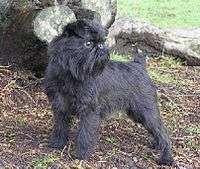 Griffon Belge
Griffon Belge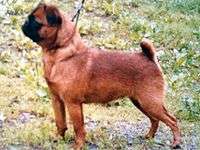 Petit Brabancon
Petit Brabancon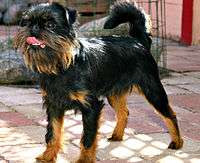 Brussels Griffon
Brussels Griffon
Health
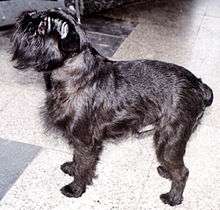
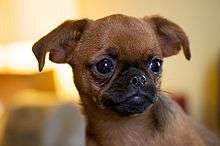

Griffons have relatively few inherited health problems, but should still be tested for congenital defects, the most serious of which are Syringomyelia (SM) and Chiari-like malformation (CM).[5] The typical life span of a Griffon is somewhere in the range of 10 to 15 years.[6]
Birthing
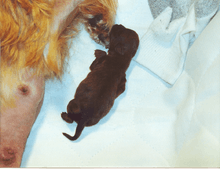
Griffons usually have no trouble whelping on their own, but sometimes complications can necessitate a Caesarean section. The size of a litter is typically 1-3 puppies. The size of the litter often determines the extent of these complications. Litters of six are not unheard of. When they are born, the puppies only weigh but a few ounces and are small enough to fit in the palm of an adult's hand. It can get leg and heart problems from an early age.
Cleft palate
One issue that is typically fatal for the puppies is having a cleft palate. It results in the puppy not receiving nourishment from the mother and eventually starvation. It is uncommon but, depending on the size of the cleft, it is possible for the puppy to survive where as it becomes older surgery can be done to close the hole.
Eyes
Most have large eyes that may require rechecks from a veterinarian.
- Lacerations - Lacerations are a common issue amongst the breed. Because the Griffons have such large eyes and a short snout, there is very little there to protect their vision from foreign bodies. If a laceration is left untreated it can result in blindness.
- Cataracts - As with most breeds, cataracts are a common problem as the dog ages. For many breeders it is a disappointment that the cataracts typically develop long after the dog has already been bred.[7]
- Lens Luxations - Lens luxations can be fairly common in the breed and result in secondary glaucoma[7]
- Glaucoma - Glaucoma can also be a common issue amongst Griffons owing to the breed's facial features and eye size.[7]
Heat Stroke
Although Griffons have a shortened snout, heat stroke is not a major concern for them as it is with other flat-faced breeds. The breed's shortened muzzle may cause respiratory problems in extreme heat, but overall they tolerate both hot and cold weather well. As with any breed, owners must use common sense and not leave them outdoors without protection from the elements or subject them to rigorous exercise during extreme temperatures, so let them in your house for cool air and some water.
Syringomyelia
Syringomyelia (SM) is a condition affecting the brain and spine, causing symptoms ranging from mild discomfort to severe pain and partial paralysis. Syringomyelia is characterised by fluid filled cavities within the spinal cord. SM occurs secondary to obstruction of cerebrospinal fluid (CSF) especially if that obstruction is at the foramen magnum. To date the condition has been also reported in Cavalier King Charles Spaniels, King Charles Spaniels, Yorkshire Terriers, Maltese Terriers, Chihuahuas, Miniature Dachshunds, Miniature/Toy Poodles, Bichon Frisé, Pugs, Shih Tzus, Pomeranians, Boston Terriers, French Bulldogs, a Pekingese, a Miniature Pinscher, mixbreeds, and a couple of cats.
Not all dogs with SM have clinical signs. The presence of signs is correlated to the width of the syrinx and extent of spinal cord dorsal horn damage. Syrinxes can progressively expand and a dog which is asymptomatic in early life may eventually experience pain.
Griffon Bruxellois in popular culture
- The American impressionist painter Mary Cassatt kept Brussels Griffons and frequently portrayed them in her paintings.[8]
- In the film As Good as It Gets (1997), as Verdell, played by six Brussels Griffons, named Timer, Sprout, Debbie, Billy, Parfait, and Jill the star[9]
- In the film Gosford Park, as Rolf Liechti's dog Kiki
- In the film Sweet November, as Sara's dog Ernie
- In the sitcom Spin City, as Carter's suicidal dog Rags, played by a smooth-coated Petit Brabançon named Wesley
- In the film Teaching Mrs. Tingle, as Mrs. Tingle's dog.
- Monkey, owned by record label owner and deejay Sarah Lewitinn and named "Best Dog Owned by a Club Personality" by The Village Voice[10][11]
- Tazzie owned by Stanley Dangerfield, appearing on the television show The Good Companions[12]
- In the film First Wives Club owned by Diane Keaton's character.
- In the sitcom "Mike and Molly" Mikes mom's dog, Jim is a Brussels Griffon mixed with a Chihuahua.
- The Southern California craft brewery "The Bruery" brewed a sour brown ale called Griffon Bruxellois.
- The makeup for the Ewok characters in the film Return of the Jedi (1983) in the Star Wars universe was developed by make-up artist Stuart Freeborn, who built them from designs by visual effects director Joe Johnston using the image of the Griffon Bruxellois, a dog breed which George Lucas owned.[13][14]
See also
References
- 1 2 3 Brief Historical Summary from the Fédération Cynologique Internationale breed standards. (DOC file)
- ↑ "American Kennel Club - Brussels Griffon History". American Kennel Club. Retrieved 2008-01-07.
- ↑ The Griffon Bruxellois Club - Founded 1897
- ↑ American Brussels Griffon Association Chronology
- ↑ Health issues:, Canine Inherited Disorders Database, , Health advice on Brussels Griffons
- ↑ "Individual Breed Results for Purebred Dog Health Survey".
- 1 2 3 Weiss, Seymour N. Brussels Griffon: A Complete and Reliable Handbook. Neptune City, NJ: T.F.H Publications Inc.
- ↑ "Mary Cassatt was a fellow griffoniac". NYC Brussels Griffon (self-published)). Archived from the original on 3 December 2013.
- ↑ As Good As It Gets (1997) at the Internet Movie Database
- ↑ Elisabeth Donnelly (2006-11-10). "Hanging With". The Boston Globe. Retrieved 2007-11-27.
- ↑ Tricia Romano (2006-12-11). "Fly Life Night Life Awards". Village Voice. Retrieved 2007-11-27.
- ↑ Raynham, Doone (1998). The Griffon Bruxellois. Kingdom Books England.
- ↑ Star Wars: Episode VI - Return of the Jedi (1983) at the Internet Movie Database
- ↑ Michael (2015-06-02). "Did Shih Tzus inspire the Ewoks from Star Wars? with cites". PoliteDog.com. Retrieved 2015-12-23.
External links
| Wikimedia Commons has media related to Belgium Griffons. |